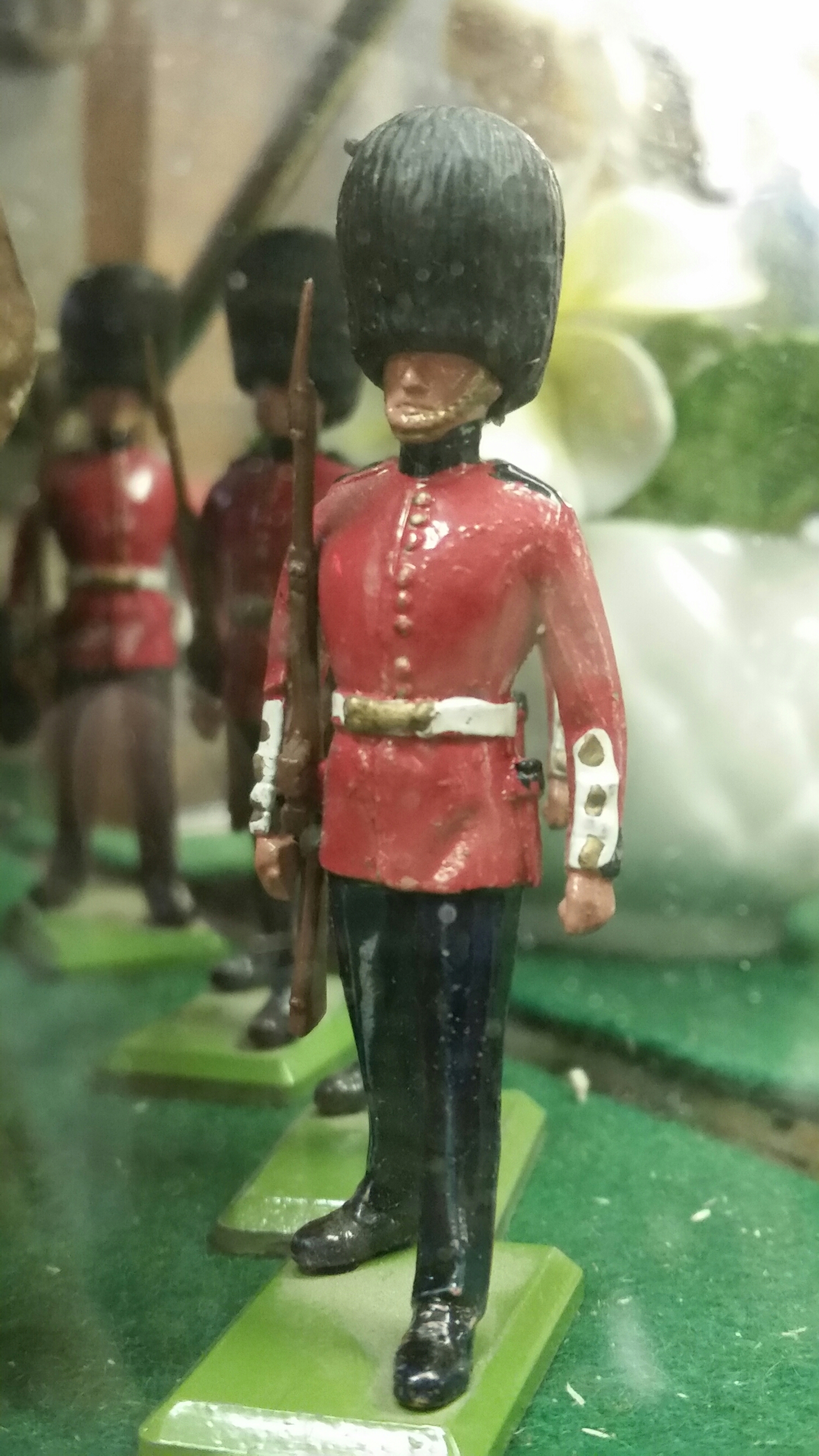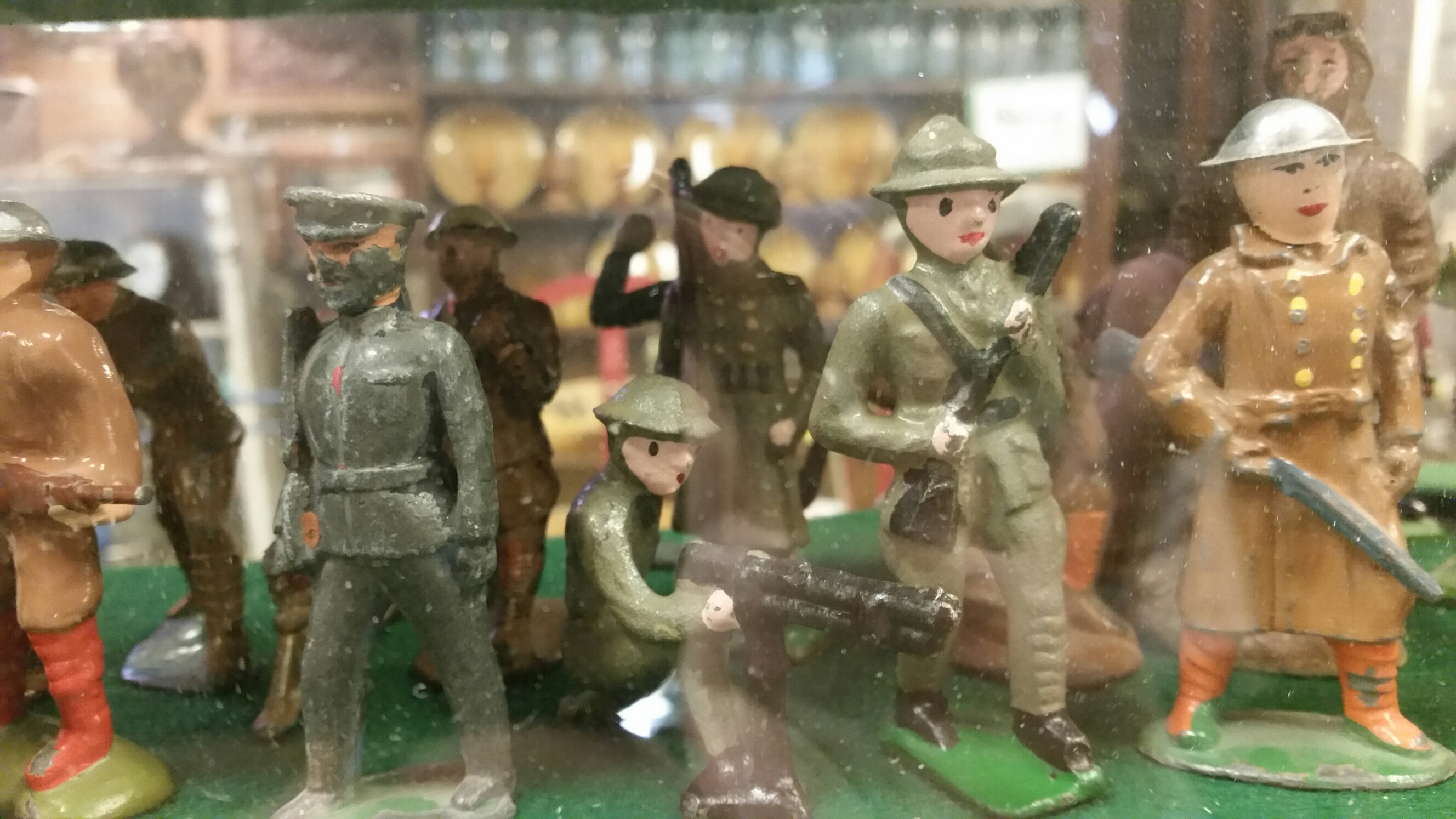In Hans Christian Andersen’s fairy tale “The Steadfast Tin Soldier,” the romantic trials of an unfinished toy soldier end in molten-metal heartbreak as the character is consumed by fire. Fortunately, countless other diminutive soldiers, made primarily in tin, lead, composite, and plastic, survived their battle-filled days of youth to become treasured keepsakes for children and adults alike.
The term “toy soldier” generally refers to any miniature human figure that represents a military or combat character. Unlike modern action figures such as G.I. Joe, most are measured in millimeters and stand between 45 and 75 mm tall, or no more than a few inches in height. Though miniature warrior figurines found in Egyptian tombs have been dated to 2500 BC, those were created for ritual purposes rather than as playthings. Similarly, across Medieval Europe, generals and monarchs had miniature armies crafted for them in silver, porcelain, or wood for use during war-strategy sessions.
The earliest soldier figurines designed specifically as children’s toys appeared in Europe during the 18th century, aimed at the affluent aristocracy who could afford a product with expensive detailing and fine craftsmanship. Those carved from wood rarely survived their owner’s childhood, while costly silver soldiers were invariably melted down for their raw material value after their owners grew up.
Toward the end of the 18th century, metalworkers building household items and doll house furniture sometimes produced cheap tin figures in their spare time. Known as “flats,” these two-dimensional soldiers were sold unpainted. The first mass-produced toy soldiers were made in Germany during the 19th century. Like their two-dimensional predecessors, these engraved characters, produced by companies such as Heinrichson, Heyde, and Gebrüder Riechewere, were also depicted in silhouette. Johann Gottfried Hilpert established an early assembly-line for his soldiers; female painters applied a single color on each figurine as it was passed around the workshop.
In the late 19th century, the growing market for toy figures allowed companies to invest in more realistic, three-dimensional or “solid” products. These models were made by pouring molten lead into a mold and extracting the solid figurine after cooling. Heads were often made using a separate mold and later attached to the figure, which was then carefully painted by hand. Companies like Mignot and Lucotte in France or Heyde in Germany created these solid toys to resemble members of various European militaries, often in ceremonial dress and posture. Heyde’s range soon expanded to include military cooks and nurses in addition to troops in uniform.
The miniature soldier market was completely transformed in 1893 when William Britain invented a process for hollow-casting lead. Britain’s hollow-cast system involved pouring molten lead into a mold that was turned as the metal cooled, with a small opening allowing for excess lead to escape. The finished product was a hollow figurine considerably cheaper and lighter than earlier designs.
Some of the company’s most interesting figures are its foreign military series, like the Egyptian Camel Corps or Indian Cavalry of 1896. Britains became the leading producer of toy soldiers, though its methods were soon imitated by companies like A. Fry, BMC, Reka, C.D. Abel & Co., and Hanks Bros...
Military figures have been found in ancient Egyptian tombs, and have appeared in many cultures and eras. Tin soldiers were produced in Germany as early as the 1730s, by molding the metal between two pieces of slate. Toy soldiers became widespread during the 18th century, inspired by the military exploits of Frederick the Great. Miniature soldiers were also used in the 17th, 18th, and 19th centuries by military strategists to plan battle tactics by using the figures to show the locations of real soldiers. In 1893, William Britain revolutionized the production of toy soldiers by devising the method of hollow casting, making soldiers that were cheaper and lighter than their German counterparts.
In addition to Britains, there have been many other manufacturers of toy soldiers over the years. For example, John Hill & Company produced hollow cast lead figures in the same style and scale. Companies such as Elastolin and Lineol were well known for their composite figures made of glue and sawdust that included both military and civilian subjects. After 1950, rising production costs and the development of plastic meant that many shop keepers liked the lighter, cheaper, and far less prone to break in transit polythene figure. This led to greater numbers of plastic toy soldiers.[2][3] The first American plastic soldiers were made by Beton as early as 1937. The first plastic toy soldiers produced in Great Britain were made in 1946 by Airfix before they became known for their famous model kits range.
One large historical producer in plastic was Louis Marx and Company, which produced both realistic soldiers of great detail and also historical collections of plastic men and women, including the “Presidents of the United States” collection, “Warriors of the World”, “Generals of World War II”, “Jesus and the Apostles”, and figures from the Coronation of Queen Elizabeth II. Marx also produced boxed playsets that featured many famous battles with armies of two sides, character figures, and terrain features. Britains produced plastic figures under the brand names of Herald and Deetail. Also in England, the scale model company, Airfix produced a variety of high quality plastic sets, which were frequently painted by hobbyists. Many Airfix figures were imitated by other companies and reproduced as inexpensive, bagged plastic army men. Timpo Toys, Britains main competitor in terms of sales and quality in the 1960s and 70s developed the ‘Over – Moulding’ system. Different coloured plastics were injected into the mould at various stages, creating a fully coloured figure without the need of paint.
During the 1990s, the production of metal toy-grade painted figures and connoisseur-grade painted toy soldiers increased to serve the demands of the collectors’ market. The style of many of these figures shifted from the traditional gloss-coat enamel paint to the matte-finished acrylic paint, which allows for greater detail and historical accuracy. The change was largely inspired by the introduction of very high quality painted figures from St. Petersburg, Russia









